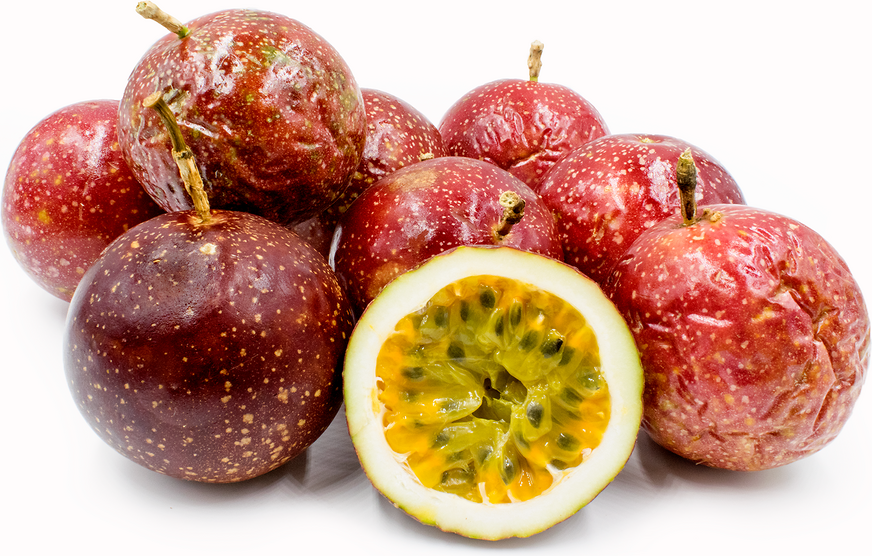


Panama Red Passionfruit
Estimated Inventory, lb : 0
Description/Taste
Panama Red passionfruit is a tropical fruit that grows on a climbing vine. This variety of passionfruit is spherical or ovate, roughly the size of a goose egg, and measures about 9 centimeters in diameter. Its skin ranges from burgundy-red to purple, featuring a thick, slightly wrinkled, and soft texture. The yellow pulp encases numerous shiny brown or black seeds. The vine is adorned with deeply lobed evergreen leaves that have serrated edges and is characterized by its showy, aromatic flowers. Panama Red Passionfruit is known for its distinctive, highly aromatic fragrance, which is sweet and slightly tart, evoking a tropical blend of citrus and guava notes. Its flavor is notably sweet with mild acidity and a musky, guava-like aftertaste.
Seasons/Availability
Panama Red passionfruit is available year-round, peaking from late spring through autumn.
Current Facts
Panama Red passionfruit, botanically known as Passiflora edulis, belongs to the Passifloraceae family. Among the estimated 500 species in this family, it holds the exclusive designation as passionfruit. This species features two primary varieties: the standard purple and the yellow. Each variety not only differs in color but also exhibits unique characteristics. The purple variety also encompasses the red and black granadilla passionfruits and is known as lilikoi in Hawaii. The yellow variety is commonly called yellow passionfruit or yellow lilikoi in Hawaii. Originally from South America, Panama Red passionfruit is particularly popular in Australia. This vigorous plant can produce between 100 to 150 fruits per season, attracts butterflies, and, although it dies back after frosts, it can regrow from the roots. Panama Red passionfruit is valued as an ornamental plant, frequently used to adorn fences or trellises.
Nutritional Value
Panama Red passionfruit contains vitamins A and C, which enhance skin health, bolster the immune system, improve vision, and offer robust antioxidant protection. It is also rich in potassium and iron, essential nutrients that support cardiovascular health, muscle and nerve function, immune health, cognitive function, and overall energy levels. This fruit is a good source of fiber, which promotes healthy digestion and maintains gut health. Passion fruit seeds contain a compound called ‘piceatannol’ that is known to improve insulin sensitivity, making it beneficial in managing and potentially preventing diabetes. Regular consumption of Panama Red passionfruit may help reduce the risk of various health issues, including cardiovascular and neurological disorders, thereby supporting the health of vital organs such as the heart and brain.
Applications
Panama Red passionfruitis can be enjoyed raw, cooked, dried, or preserved in jams and jellies. Both the pulp and seeds are edible, while the skin should be discarded. It's often simply sliced open and eaten on its own or mixed into a fruit salad with other tropical fruits. The juice can be strained for use in cocktails, syrups, marinades, or as a flavorful addition to juices. This passionfruit also enhances desserts like cakes, tarts, pastries, ice creams, sorbets, and meringues. In beverages, it's a key ingredient in Hawaiian Punch, enriches the flavor of alcoholic drinks, and can be infused into water for a refreshing twist. Culinary uses extend to being diced for salsas or as a topping for tropical curries. It's also excellent in yogurt parfaits, smoothies, and chia puddings. Panama Red passionfruit pairs well with ginger, mint, vanilla, caramel, and complements salty cheeses, kiwi, mango, oranges, strawberries, blueberries, and papayas. Store it in the refrigerator for up to two weeks. Note that all young, unripe passionfruits contain a toxic cyanogenic glycoside in their pulp, so it's crucial to consume only ripe, mature fruit to ensure safety.
Ethnic/Cultural Info
Panama Red passionfruit is highly valued in Australia, often costing twice as much as other varieties. It has become a naturalized weed throughout eastern and southern Australia, as well as on Lord Howe Island and Norfolk Island. The name "Passionfruit" was coined around 1700 by missionaries in Brazil as a teaching tool to aid in converting indigenous people to Christianity, referring to it as flor das cinco chagas or the flower of the five wounds, symbolizing the crucifixion of Christ. Passionfruit likely spread from cultivated areas, aided by flying foxes which consume the fruit and disperse the seeds. While it might be tempting to leave the vines for fruit harvesting, flying foxes typically reach the fruit first and contribute to its spread as a weed. Passionfruit is also a key ingredient in Pavlova, a dessert named after the Russian ballerina Anna Pavlova. This meringue-based cake features a crisp crust and soft, marshmallow-like interior, traditionally topped with whipped cream and fresh fruits such as passionfruit, strawberries, or kiwi. Pavlova is especially popular in Australia and New Zealand, both of which claim the dessert was created during Pavlova's tours to these countries in the 1920s.
Geography/History
Panama Red passionfruit, native to South America, particularly Brazil, Paraguay, and Argentina, thrives in warm, tropical, and subtropical climates. Unlike many fruits, it is not typically found in the wild but is cultivated in gardens and on farms for commercial production. The variety's vigorous growth and relatively high yield compared to other passionfruit types have facilitated its spread beyond its native region. With the expansion of global trade, the availability of exotic fruits like Panama Red passionfruit has increased in markets worldwide. This growth in availability has been driven by rising consumer interest in exotic and tropical fruits. Today, Panama Red passionfruit can be found in grocery stores and farmers' markets in places like Australia, parts of the United States, and other tropical regions, and it is also commonly grown in tropical gardens.














